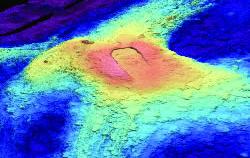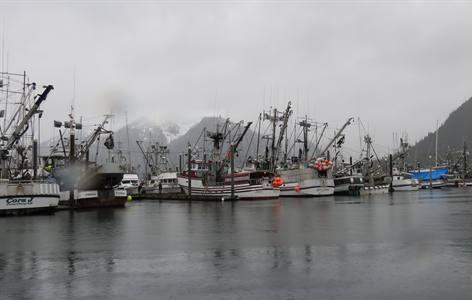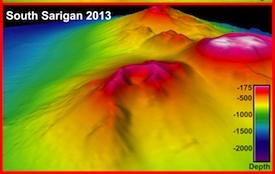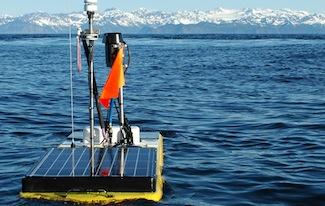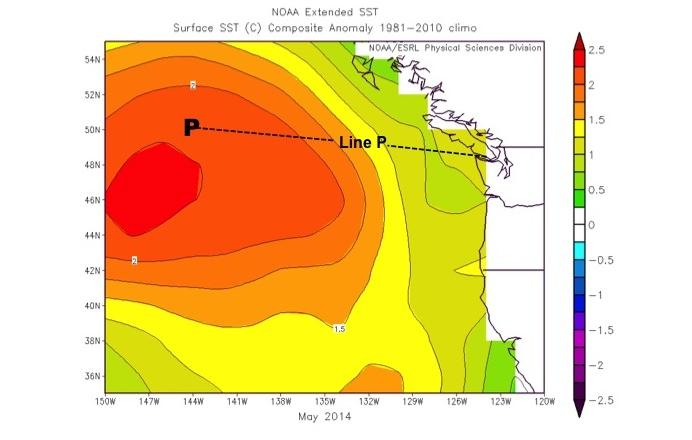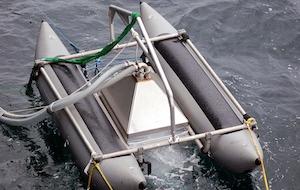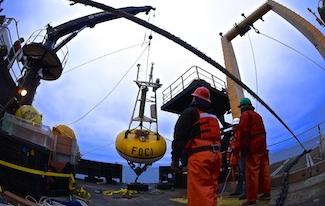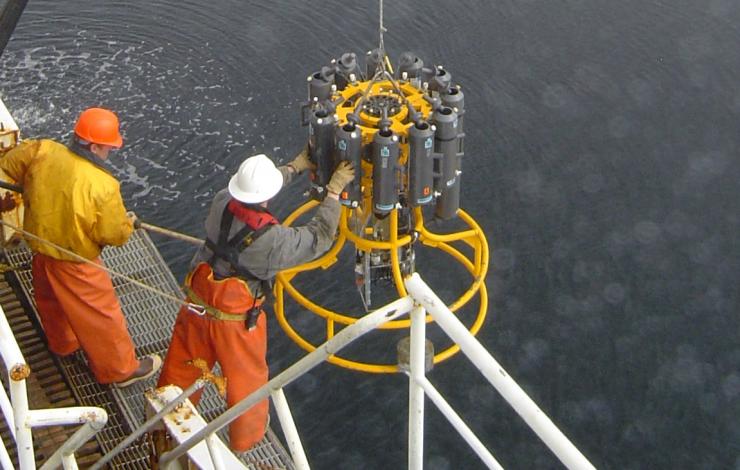What's New Archive
Starting on August 10, scientists and engineers from PMEL and the Joint Institute for the Study of Atmosphere and Ocean will be leading a mission on the NOAA Ship Ronald H. Brown using the remotely operated vehicle Jason II to conduct time-series observations and sampling at the New Millenium Observatory (NeMO) at Axial Seamount off the Oregon coast, the site of a long-term seafloor observatory (since 1998!).
A new microbial incubator, developed and built by PMEL engineers, will be deployed on Jason to conduct microbial growth experiments on the seafloor. Also included on this mission are the recovery of heat-energy extraction test instruments deployed in 2013 and collection of large-volume samples for the study of viruses in hydrothermal fluids. Please visit PMEL's Earth-Ocean Interactions website for more information on NeMO.
A new study led by PMEL's Dr. Jeremy Mathis, published online July 29 in Progress in Oceanography, shows that many of Alaska's economically valuable marine fisheries are located in waters already experiencing ocean acidification. The economy and livelihood of communities in southeast and southwest Alaska are expected to be particularly vulnerable to ocean acidification and have underlying factors making these communities more susceptible. Studies show that red king crab and tanner crab, two important Alaskan fisheries, grow more slowly and don’t survive as well in more acidic waters. Alaska’s coastal waters are particularly vulnerable to ocean acidification because of cold water that can absorb more carbon dioxide, and unique ocean circulation patterns which bring naturally acidic deep ocean waters to the surface.
Read more on the NOAA press release and visit PMEL's ocean acidification research page.
An article just published in Oceanography by PMEL’s Dr. Robert Embley and collaborators at Japan's JAMSTEC, Oregon State University (CIMRS), Washington University, and the University of Texas, Dallas describes the site of a 2010 submarine eruption of a 200 meter deep seamount in the Mariana arc that was powerful enough to produce an atmospheric plume. Comparisons of pre- (2002) and post- (2013) eruption bathymetric surveys reveal a new 400m diameter crater. This new map targeted dives with a JAMSTEC remotely operated vehicle in 2013. This new information will help evaluate the hazard potential of submarine eruptions.
For more information please visit the PMEL Earth-Ocean Interactions website.
Led by Dr. Jeremy Mathis, PMEL teamed up with the University of Alaska and the Alaska Ocean Observing System this summer and early fall to use new unmanned tools to study how melting glaciers in Alaska’s Prince William Sound may be intensifying ocean acidification in the sound and on the Gulf of Alaska continental shelf. PMEL engineers outfitted two Carbon Wave Gliders and one underwater Slocum glider with sensors to help better understand the unique processes of glacial melt water and how they change the chemistry of the water column in Prince William Sound.
To read more about this project please visit the NOAA Research News website.
Researchers at PMEL and JISAO are monitoring an area of warm surface water that has been occupying the Northeast Pacific near Ocean Climate Station Papa buoy. This mass of water, nicknamed “The Blob”, was about 3 degrees Celsius warmer than normal in February and is maintaining its abnormal heat into the summer. The warm water has implications for the marine ecosystem and could affect the weather in the Pacific Northwest. Past summers with especially warm water off the coast have tended to be warmer and more humid than usual.
To check out the latest conditions with The Blob, visit the Ocean Climate Station Papa buoy page.
PMEL’s Dr. Trish Quinn led a group of PMEL and JISAO scientists on a recent cruise in the North Atlantic Ocean to assess how ocean biogeochemistry impacts sea spray particles. Quantifying the size and composition of sea spray particles is critical for parameterizing cloud condensation nuclei in climate models. The particles are generated using the PMEL developed Sea Sweep device that is deployed over the side of the ship to collect samples.
The study, which ended on June 5, is part of the Western Atlantic Climate Study II (WACS II) and was conducted using the Woods Hole Oceanographic Institute’s R/V Knorr. For more information please visit PMEL’s Atmospheric Chemistry website.
PMEL and Alaska Fisheries Science Center’s EcoFOCI program just deployed the M2 mooring in the southeastern Bering Sea for the 20th consecutive year. The mooring has been providing year-round measurements of temperature, salinity, nitrite, chlorophyll, and currents in this highly productive area since 1994. These measurements are used in annual report cards and stock assessments provided to the North Pacific Fishery Management Council. Long-term time-series at this site are a critical tool for adapting to climate change and guiding sustainable management of living resources in the Bering Sea.
Visit the EcoFOCI website for more information on their work in the Bering Sea, Gulf of Alaska, and Arctic waters.
PMEL carbon scientists Drs. Nina Bednarsek and Richard Feely were part of a NOAA-led team to find the first evidence that acidity of continental shelf waters off the West Coast dissolving the shells of pteropods. Their research, published April 30 in the Proceedings of the Royal Society B, estimates that the percentage of pteropods in this region with dissolving shells due to ocean acidification has doubled since the pre-industrial era and is on track to triple by 2050 when coastal waters become 70 more corrosive due to human-caused ocean acidification.
Read more on the NOAA press release and the PMEL Carbon Group ocean acidification page.
NOAA Arctic Program Leads, including PMEL scientist and Arctic expert Dr. James Overland, collaborated on the development and recent publication of NOAA's Arctic Action Plan. The plan provides a roadmap to making shared progress in monitoring, understanding, and protecting the vulnerable Arctic region. PMEL is actively involved in Arctic climate dynamics research, conducting observations and evaluating models of Arctic sea ice to document and predict climate change impacts on Arctic marine ecosystems.
Find out more on the NOAA Arctic theme page and PMEL Arctic research web pages.
The Bering Sea Project, a 6-year multidisciplinary program encompassing the work of more than 100 collaborating scientists, has led to major new understanding of the role of sea ice and changing climate in one of the world’s most commercially viable fisheries. The timing of spring sea ice retreat influences large zooplankton yields, an important prey species, and impacts pollock recruitment in the Bering Sea Fisheries.
Results were presented at the Bering Sea Open Science Meeting and EcoFOCI’s major contributions to the program are published in a series of Headline Articles and Deep Sea Research II special issues.



